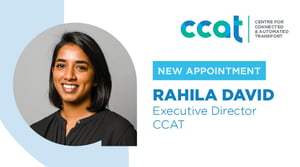
The Centre for Connected and Automated Transport (CCAT) has appointed Rahila David as its inaugural Executive Director.
CCAT will be focusing primarily on the application of autonomous and connected technology to transport rather than the development of the technology itself. Its mission is to bring together Government and industry in a new partnership to focus on how the infrastructure that is being planned, built and maintained will be able to enable a connected and automated future.
Formerly leading the National Transport Commission’s work to build the safety assurance framework for the commercial deployment of automated vehicles (AVs), Ms David brings a wealth of knowledge to the role as Executive Director of CCAT.
“After being heavily involved in developing the regulatory frameworks for AVs, I’m looking forward to stepping into the role of Executive Director for CCAT, to focus on how we ready the transport system for the arrival of connected and automated technology,” said Ms David.
Michael Caltabiano, Chief Executive Officer of ARRB, is looking forward to Ms David’s appointment given her background and experience in policy and stakeholder roles in the transport sector.
“We have been fortunate to appoint an Executive Director with the combination of skills to manage the challenge. Rahila David has a record of success in senior policy and stakeholder roles within the Automated Vehicle Program in the National Transport Commission. She holds degrees in Law and Arts from Victoria University in Wellington, NZ, and a master’s degree in public policy from the London School of Economics. This is an ideal combination of technical knowledge, policy development and stakeholder engagement,” said Mr Caltabiano.
CCAT will not only be about roads, but will extend to all transport applications including rail, ports, airports, freight, mining, agriculture and digital.
Prioritising infrastructure, digitisation, uniform standards, and safety, CCAT’s biggest opportunity is to facilitate Australia’s and New Zealand’s transition to an automated future.
“It’s time to gear up the agenda. CCAT will be a hub for industry discussion about our automated future. The priority for Australia and New Zealand is to provide the infrastructure that will capture the full benefits of automated transport. The need extends beyond passenger cars – it includes rail, mining, ports, agriculture, airports, agriculture, freight, and artificial intelligence applications, to name a few. The economic benefits are compelling, and they are reinforced by industrial and road safety,” Mr Caltabiano said.
With trials of CAVs and related technology well under way in Australia, Ms David is looking forward to taking automated and connected technology to the next stage of deployment onto our transport network across both Australia and New Zealand.
“Australia and New Zealand are doing well to progress AV trials of increasing complexity. We’ve also been at the forefront of developing regulatory frameworks, and a great deal of research is under way on the necessary infrastructure to support a future CAV environment. Industry are progressing new applications and business models and there are many benefits to be gained from the technology. We need to develop a vision for the deployment of connected and automated technology in transport and find a cohesive pathway forward to get to that end-state,” Ms David said.
CCAT is a membership based organisation, open to government agencies and companies with a stake in Australia and New Zealand’s transport future. Transport agencies, innovative local councils, industry participants big and small, technology and motor manufacturers, mining companies, the agricultural sector, researchers, next-gen technology developers and start-ups are invited to join.
If you would like to find out more about CCAT or become a member, sign up today via www.ccat.org.au or contact us via info@ccat.org.au.
